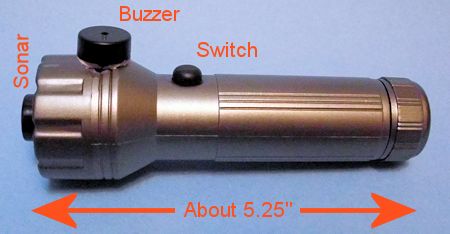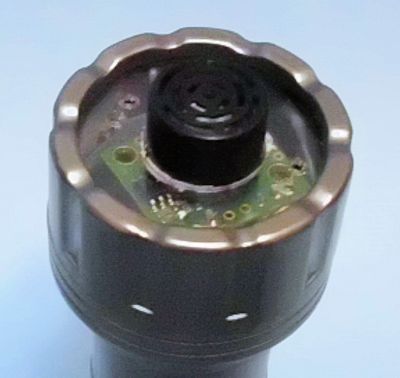Over the past week I finally finished my Tacit glove version, and put the sonar eye code into a prototype that wasn’t dangling wires like the original.
Over the next week I’ll be posting more details, but for now here’s the Sonar Eye prototype, mini version:

For this version I left off the vibration motor (hard on the power supply, and hard to detect speed differences), and the sine wave (irritating over time).
Instead, Oriano and I talked about a ‘Geiger Counter’ style sound wave, using the ticking sound you hear in old fashioned Geiger counters. It sounds out a series of ticks as you point the device around the room, with ticking spread farther apart when you are far from an obstacle, and closer together when you get close.
The device is simple and (fairly) inexpensive to build:
- I found a local supply of LED flashlights, which are designed to provide 4.5 (3 AAA batteries in series) to do the job. Removing the LEDs in front, and drilling a hole for the sensor gave me most of the product.
- I used an Arduino Pro Mini for the controller. I got addicted to them when building the Tacit glove – solder wires to it and power up, and you’ve added an Arduino on a postage stamp!
- A cheap passive piezoelectric buzzer for the tick. There are two types of buzzers out there, passive and active (at least, for my needs). Active ones include buzzer circuitry, and you only need add power to get a tone (connect a battery to one and it will sound off). But a passive one is driven by the circuit, and in this case, it means a cleaner sound with the Arduino (more programming effort, though).
- The Maxbotix LV-EZ1 sonar rangefinder again. With only one sensor, it fit nicely in the flashlight’s front. The result looks really nice:

- Miscellaneous. Besides wiring, I also added a diode on the wire coming from the +4.5v power supply. Since the power pack could be inserted wrong, this made sure there was no chance of frying the circuit in that case. The disadvantage is that the device drops 0.7v across the connection, but there’s still enough to run things (another option would be to use a Schottky diode, which has only a 0.3v drop).
Low part count, low cost. It’s a device that provides an option for those not able to see, and find out what’s out and about. And I’m not just thinking the Blind – as the Missus pointed out, this could be a cool survivalist device, just in case you should be permanently/temporarily blinded in a catastrophe.
Now with the second prototype out (and the first really portable one), it’s time to get feedback from others and work on a third:
- Already, Oriano has pointed out the need for a headphone jack, and actually liked the tone from the first prototype (although my other beta tester, Heidi, found the tone too harsh).
- As well, the motor might be worthwhile to add in again for use on ‘silent’ occasions, like working through a crowd at a large event, where audio cues are mostly useless. In this case, the motor needs to provide some new kind of useful signal, perhaps by cycling up and down quickly.
- I’m keeping the Geiger counter in it, though – the tick is nice and mild, yet penetrating and fairly easy to hear.
So the third prototype might well include the original audio+motor, but with a switch to go between them, and better sound/vibration information, and volume controls. Add three switches, and the motor+transistor, and I think I’m almost there…
